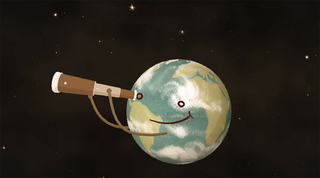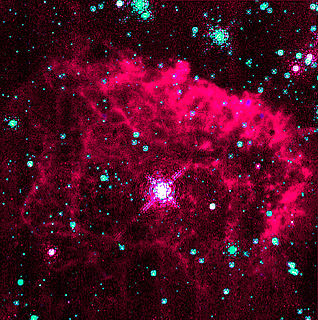 W
WAsteroid Zoo is a citizen science project run by the Zooniverse and Planetary Resources, to use volunteer classifications to find unknown asteroids using old Catalina Sky Survey data. The main goals of the project are to search for undiscovered asteroids in order to protect the planet by locating potentially harmful near-Earth Asteroids, locate targets for future asteroid mining, study the solar system, and study the potential uses and advantages of people looking through the images over computers. It was created along with the ARKYD project through Kickstarter, funded with just over 1.5 million dollars.
 W
WBackyard Worlds: Planet 9 is a NASA-funded citizen science project which is part of the Zooniverse web portal. It aims to discover new brown dwarfs, faint objects that are less massive than stars, some of which might be among the nearest neighbors of the Solar System, and might conceivably detect the hypothesized Planet Nine. The project's principal investigator is Marc Kuchner, an astrophysicist at NASA's Goddard Space Flight Center.
 W
WBeagle 3 was a proposed Mars lander mission to search for life on Mars, past or present. Beagle 3 was the proposed successor to the failed British Beagle 2 Mars lander, with which communication was lost. Beagle 3 was promoted by Professor Colin Pillinger, lead scientist on the Beagle 2. EADS Astrium also played a part in funding and early development of the project. Pillinger dreamed of launching up to two landing craft from an orbiter in 2009 as part of the European Space Agency's Aurora Programme. The putative Beagle 3 would be named after the ship HMS Beagle that took Charles Darwin around the world.
 W
WThe Center for Detectors (CfD) is a Rochester Institute of Technology College of Science academic research center. The CfD, established in January 2010 by Dr. Donald Figer, began as an expansion of the Rochester Imaging Detector Laboratory. Its mission is to enable scientific discovery, national security, better living, and commercial innovation through the design and development of advanced photon detectors and associated technology.
 W
WCosmic-Ray Extremely Distributed Observatory (CREDO) is a scientific project initiated at the end of August 2016 by Polish scientists from the Institute of Nuclear Physics in Kraków whose purpose is the detection of cosmic rays and the search for dark matter. Its aim is to involve as many people as possible in the construction of a global system of cosmic ray detectors, from which it will be possible to examine the essence of dark matter. Having a camera and a GPS module, a smartphone works well as a detector of particles from space.
 W
WThe Digital Access to a Sky Century @ Harvard (DASCH) is a project to preserve and digitize images recorded on astronomical photographic plates created before astronomy became dominated by digital imaging. It is a major project of the Harvard–Smithsonian Center for Astrophysics. Over 500,000 glass plates held by the Harvard College Observatory are to be digitized. The digital images will contribute to time domain astronomy, providing over a hundred years of data that may be compared to current observations.
 W
WA Dyson sphere is a hypothetical megastructure that completely encompasses a star and captures a large percentage of its power output. The concept is a thought experiment that attempts to explain how a spacefaring civilization would meet its energy requirements once those requirements exceed what can be generated from the home planet's resources alone. Only a tiny fraction of a star's energy emissions reaches the surface of any orbiting planet. Building structures encircling a star would enable a civilization to harvest far more energy.
 W
WThe Extremely Large Telescope (ELT) is an astronomical observatory currently under construction. When completed, it is planned to be the world's largest optical/near-infrared extremely large telescope. Part of the European Southern Observatory (ESO) agency, it is located on top of Cerro Armazones in the Atacama Desert of northern Chile.
 W
WGalaxy Zoo is a crowdsourced astronomy project which invites people to assist in the morphological classification of large numbers of galaxies. It is an example of citizen science as it enlists the help of members of the public to help in scientific research.
 W
WThe Milky Way Project is a Zooniverse project whose main goal is to identify stellar-wind bubbles in the Milky Way Galaxy. Users classify sets of infrared images from the Spitzer Space Telescope and the Wide-field Infrared Survey Explorer (WISE). Scientists believe bubbles in these images are the result of young, massive stars whose light causes shocks in interstellar gas.
 W
WSince its establishment in 1958, NASA has conducted research on a range of topics. Because of its unique structure, work happens at various field centers and different research areas are concentrated in those centers. Depending on the technology, hardware and expertise needed, research may be conducted across a range of centers.
 W
WThe Optical Gravitational Lensing Experiment (OGLE) is a Polish astronomical project based at the University of Warsaw that runs a long-term variability sky survey (1992-present). The main goals are the detection and classification of variable stars, discovery of microlensing events, dwarf novae, and studies of the structure of the galaxy and the Magellanic Clouds. Since the project began in 1992, it has discovered a multitude of extrasolar planets, together with the first planet discovered using the transit method (OGLE-TR-56b) and gravitational microlensing. The project has been led by professor Andrzej Udalski since its inception.
 W
WPlanet Hunters is a citizen science project to find exoplanets using human eyes. It does this by having users analyze data from the NASA Kepler space telescope and the NASA Transiting Exoplanet Survey Satellite. It was launched by a team led by Debra Fischer at Yale University, as part of the Zooniverse project.
 W
WPlanetary protection is a guiding principle in the design of an interplanetary mission, aiming to prevent biological contamination of both the target celestial body and the Earth in the case of sample-return missions. Planetary protection reflects both the unknown nature of the space environment and the desire of the scientific community to preserve the pristine nature of celestial bodies until they can be studied in detail.
 W
WThe Space Interferometry Mission, or SIM, also known as SIM Lite, was a planned space telescope proposed by the U.S. National Aeronautics and Space Administration (NASA), in conjunction with contractor Northrop Grumman. One of the main goals of the mission was the hunt for Earth-sized planets orbiting in the habitable zones of nearby stars other than the Sun. SIM was postponed several times and finally cancelled in 2010. In addition to detecting extrasolar planets, SIM would have helped astronomers construct a map of the Milky Way galaxy. Other important tasks would have included collecting data to help pinpoint stellar masses for specific types of stars, assisting in the determination of the spatial distribution of dark matter in the Milky Way and in the local group of galaxies and using the gravitational microlensing effect to measure the mass of stars. The spacecraft would have used optical interferometry to accomplish these and other scientific goals.
 W
WThe Terrestrial Planet Finder (TPF) was a proposed project by NASA to construct a system of space telescopes for detecting extrasolar terrestrial planets. TPF was postponed several times and finally cancelled in 2011. There were two telescope systems under consideration, the TPF-I, which had several small telescopes, and TPF-C, which used one large telescope.
 W
WVISTA Variables in the Via Lactea –The VVV Survey– is observing the Milky Way's bulge and southern disk in the near-infrared using the capabilities of the VISTA Telescope at Paranal, Chile.
 W
WZooniverse is a citizen science web portal owned and operated by the Citizen Science Alliance. It is home to some of the Internet's largest, most popular and most successful citizen science projects. The organization grew from the original Galaxy Zoo project and now hosts dozens of projects which allow volunteers to participate in crowdsourced scientific research. It has headquarters at Oxford University and the Adler Planetarium. Unlike many early internet-based citizen science projects which used spare computer processing power to analyse data, known as volunteer computing, Zooniverse projects require the active participation of human volunteers to complete research tasks. Projects have been drawn from disciplines including astronomy, ecology, cell biology, humanities, and climate science.